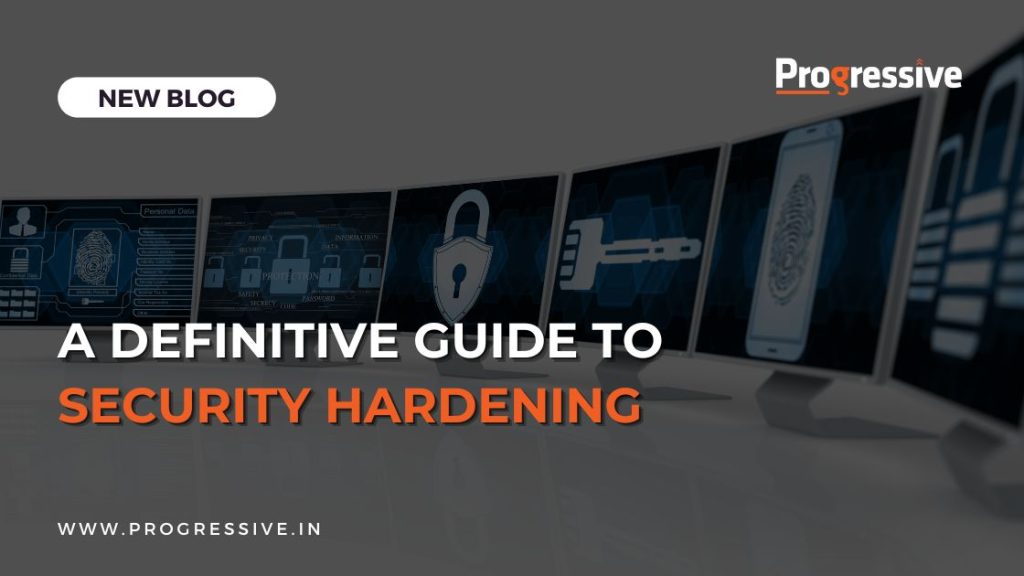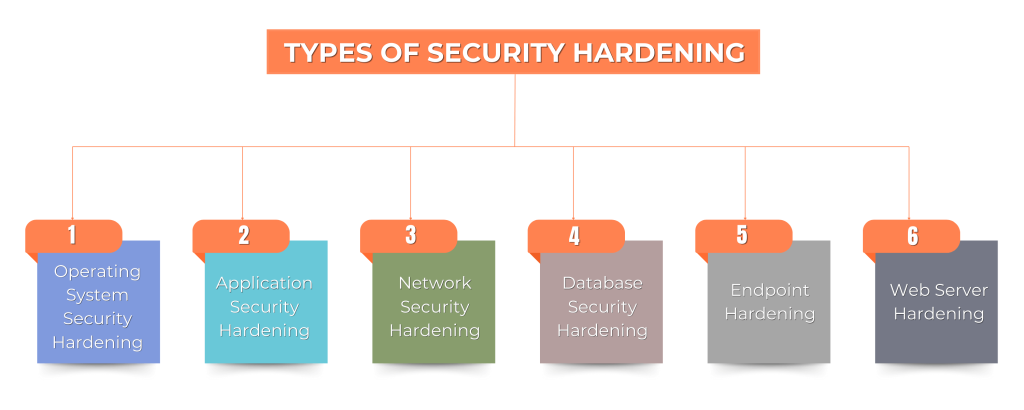
Security hardening is a proactive cybersecurity approach aimed at fortifying the defenses of systems, networks, and applications. It involves identifying and mitigating vulnerabilities that could be exploited by malicious actors to compromise security or disrupt operations.
One aspect of security hardening involves configuring software and systems according to established security best practices. This includes disabling unnecessary services, removing default accounts and passwords, and promptly applying security patches and updates.
Access control is another critical component of security hardening. This entails implementing robust authentication mechanisms, such as multi-factor authentication, and restricting access to sensitive information based on the principle of least privilege.
Encryption plays a pivotal role in security hardening by safeguarding data both at rest and in transit. This ensures that even if data is intercepted, it remains unintelligible without the decryption key.
Additionally, security hardening encompasses continuous monitoring and auditing of systems to detect and respond to security incidents promptly. This involves logging and analyzing security events to identify and mitigate potential threats.
In summary, security hardening is a fundamental practice for organizations seeking to bolster their cybersecurity posture and safeguard their assets against evolving cyber threats.
Market Research
- Based on mordorintelligence, the Application Security Market is projected to grow from an estimated USD 11.62 billion in 2024 to USD 25.92 billion by 2029, at a CAGR of 17.39% during the forecast period.
- According to Data Bridge Market Research, the database security market is anticipated to reach USD 25.97 billion by 2030, up from USD 7.05 billion in 2022, with a CAGR of 17.70% during the forecast period.
- The global network security market, valued at USD 21.46 billion in 2022, is expected to grow at a CAGR of 12.6% from 2023 to 2030. Source: grand viewer research.
6 Common Types of Security Hardening

Security hardening encompasses various types of measures designed to enhance the security of computer systems and networks. Here are some common types of security hardening:
Operating System Hardening
This involves configuring operating systems (OS) to reduce security risks. It includes disabling unnecessary services, applying security patches, configuring user permissions, and enabling security features such as firewalls and encryption.
Application Security Hardening
Application hardening involves securing software applications to prevent unauthorized access and mitigate vulnerabilities. This can include using secure coding practices, applying patches, and using application security tools.
Network Security Hardening
Network hardening involves securing network infrastructure to protect against unauthorized access and attacks. This includes implementing firewalls, intrusion detection systems (IDS), virtual private networks (VPN), and secure network protocols.
Database Security Hardening
Database hardening involves securing databases to protect sensitive data. This includes applying security patches, using strong authentication mechanisms, and implementing access controls.
Endpoint Hardening
Endpoint hardening focuses on securing individual devices (endpoints) such as computers, laptops, and mobile devices. This can include installing antivirus software, enabling firewalls, and implementing device encryption.
Web Server Hardening
Web server hardening involves securing web servers to protect against web-based attacks. This can include disabling unnecessary services, using secure protocols (e.g., HTTPS), and applying security patches.
Understanding the Necessity of Security Hardening
Security hardening is a critical aspect of cybersecurity aimed at mitigating risks and fortifying systems against potential threats. It involves implementing a series of measures to protect against cyberattacks, data breaches, and other malicious activities. Here’s a detailed look at the key risks that make security hardening necessary:
Cyberattacks
These are intentional actions aimed at compromising the security of computer systems or networks. Common cyberattacks include malware infections, denial-of-service (DoS) attacks, and phishing scams. Security hardening measures such as firewall configurations, intrusion detection systems (IDS), and regular security patching are essential to protect against these threats.
Data Breaches
A data breach occurs when sensitive information is accessed, disclosed, or stolen without authorization. Data breaches can result in financial losses, reputational damage, and legal consequences. Security hardening strategies, including data encryption, access controls, and data loss prevention (DLP) technologies, help prevent unauthorized access to sensitive data.
Malware and Ransomware
Malware is malicious software designed to disrupt, damage, or gain unauthorized access to a computer system. Ransomware is a type of malware that encrypts files or systems and demands a ransom for their release. Security hardening measures such as antivirus software, email filtering, and regular software updates are crucial to protect against malware and ransomware attacks.
Phishing and Social Engineering
Phishing is a fraudulent attempt to obtain sensitive information by disguising itself as a trustworthy entity in electronic communication. Social engineering is the practice of manipulating individuals to disclose confidential information. Security hardening includes educating users about these threats, implementing email filtering and spam detection, and conducting regular security awareness training.
Insider Threats
Insider threats refer to security risks posed by individuals within an organization, such as employees, contractors, or business partners. These threats can be intentional or unintentional and may include theft of intellectual property, data breaches, or sabotage. Security hardening includes implementing strict access controls, monitoring user activities, and conducting regular security audits to detect and prevent insider threats.
Regulatory Compliance
Many industries are subject to regulations and standards that require organizations to implement specific security measures to protect sensitive information. Examples include the Health Insurance Portability and Accountability Act (HIPAA) for healthcare organizations and the General Data Protection Regulation (GDPR) for organizations handling data of European Union (EU) residents. Security hardening helps ensure compliance with these regulations by implementing the necessary security controls and measures.
7 Effective Techniques to Harden Your System’s Security
Update and Patch Management
Explanation
Regularly applying security patches and updates is crucial to protect systems from known vulnerabilities. These updates fix bugs and security loopholes in the software, reducing the risk of exploitation by attackers.
Importance
Without regular updates, systems remain vulnerable to known attacks, which can lead to unauthorized access, data breaches, and system compromise.
Implementation
Use automated patch management tools to regularly check for and apply updates to the operating system, software, and applications.
Disable Unused Services
Explanation
Disabling or removing unnecessary services and protocols reduces the attack surface of the system. Unused services can introduce additional vulnerabilities that attackers can exploit.
Importance
By minimizing the number of running services, organizations can reduce the risk of unauthorized access and potential security breaches.
Implementation
Use the “chkconfig” command in Linux or the “Services” console in Windows to disable unnecessary services. Regularly review and update this list as necessary.
Strong Authentication
Explanation
Strong authentication mechanisms, such as complex passwords or multi-factor authentication (MFA), enhance the security of user accounts by requiring additional verification steps.
Importance
Weak authentication methods can lead to unauthorized access, data breaches, and identity theft.
Implementation
Enforce strong password policies (e.g., minimum length, complexity requirements) and consider implementing MFA for an additional layer of security.
Access Control
Explanation
Implementing access control mechanisms ensures that users have the appropriate level of access based on their roles and responsibilities.
Importance
Access control helps prevent unauthorized access to sensitive data and resources, reducing the risk of data breaches and insider threats.
Implementation
Use role-based access control (RBAC) or attribute-based access control (ABAC) to manage and enforce access permissions. Regularly review and update access controls based on changing user roles.
File System Security
Explanation
File system security involves using file permissions and encryption to protect sensitive data from unauthorized access.
Importance
Without proper file system security, attackers can easily access and manipulate sensitive files, leading to data breaches and loss of confidentiality.
Implementation
Set appropriate file permissions (e.g., read, write, execute) to restrict access to sensitive files and directories. Use encryption to protect data at rest.
Network Security
Explanation
Network security measures, such as firewalls, intrusion detection systems (IDS), and intrusion prevention systems (IPS), protect networks from unauthorized access and malicious activities.
Importance
Effective network security is essential to prevent attackers from compromising network infrastructure and accessing sensitive data.
Implementation
Deploy firewalls to monitor and control incoming and outgoing network traffic. Use IDS and IPS to detect and prevent suspicious network activities.
Logging and Monitoring
Explanation
Logging and monitoring help detect and respond to security incidents by capturing and analyzing system logs, network traffic, and user activities.
Importance
Timely detection and response to security incidents can help mitigate the impact of attacks and prevent further damage.
Implementation
Enable logging for critical systems and applications. Use security information and event management (SIEM) tools to centralize log collection and analysis. Regularly review logs for suspicious activities and take appropriate action.
Key Benefits of Security Hardening
Security hardening involves implementing a series of measures to make computer systems and networks more secure. These measures are designed to reduce the attack surface and make it more difficult for attackers to exploit vulnerabilities. Here’s an in-depth look at the benefits of security hardening:
Mitigation of Vulnerabilities
Security hardening involves identifying and addressing vulnerabilities in software, operating systems, and configurations. By patching vulnerabilities and implementing secure configurations, organizations can significantly reduce the risk of exploitation.
Enhanced Data Protection
Security hardening helps protect sensitive data from unauthorized access. By encrypting data at rest and in transit, implementing access controls, and using secure authentication mechanisms, organizations can ensure the confidentiality, integrity, and availability of their data.
Improved Compliance
Many regulatory requirements and industry standards mandate the implementation of security controls to protect data. Security hardening helps organizations comply with these requirements by implementing the necessary controls.
Reduced Risk of Cyber Attacks
By implementing security hardening measures, organizations can reduce the likelihood of successful cyber-attacks. Hardening measures make it more difficult for attackers to exploit vulnerabilities and gain unauthorized access to systems.
Increased System Reliability
Security hardening measures can improve system reliability by reducing the impact of security incidents. By implementing measures such as regular patching and secure configurations, organizations can minimize downtime and ensure systems are available when needed.
Protection Against Known Threats
Security hardening measures can protect against known vulnerabilities and attack vectors. By keeping systems up to date with the latest patches and using secure configurations, organizations can reduce the risk of exploitation by known threats.
Proactive Security Posture
By implementing security hardening measures, organizations demonstrate a proactive approach to security. This can help deter potential attackers and reduce the likelihood of successful attacks.
In conclusion, security hardening is a critical practice for organizations looking to protect their systems, networks, and data from cyber threats. By implementing security hardening measures such as updating and patching, disabling unused services, enforcing strong authentication, and implementing access control, organizations can significantly reduce their risk of cyber-attacks and data breaches. Additionally, security hardening helps organizations comply with regulatory requirements, improve system reliability, and demonstrate a proactive approach to security. Overall, investing in security hardening is essential for organizations looking to safeguard their digital assets and maintain a secure environment.
At Progressive, our security hardening services are tailored to empower organizations in fortifying their digital defenses and safeguarding against evolving cyber threats. With our expertise in identifying vulnerabilities and implementing robust security measures, we ensure that your systems, networks, and applications are fortified against potential breaches and unauthorized access. By partnering with Progressive for security hardening, organizations can enhance their cybersecurity posture, mitigate risks, and instill confidence in their digital operations. Book a call now and Take proactive steps towards securing your digital assets today by partnering with Progressive for comprehensive security hardening solutions.